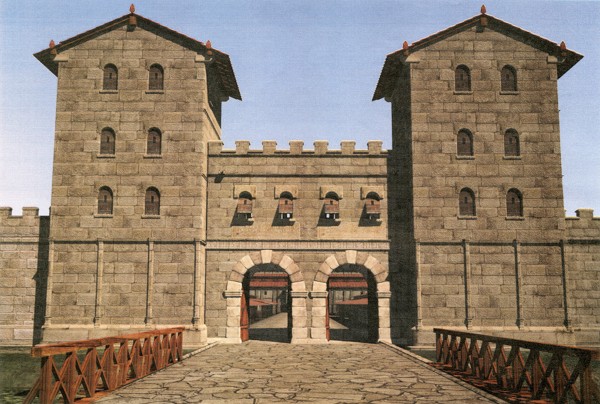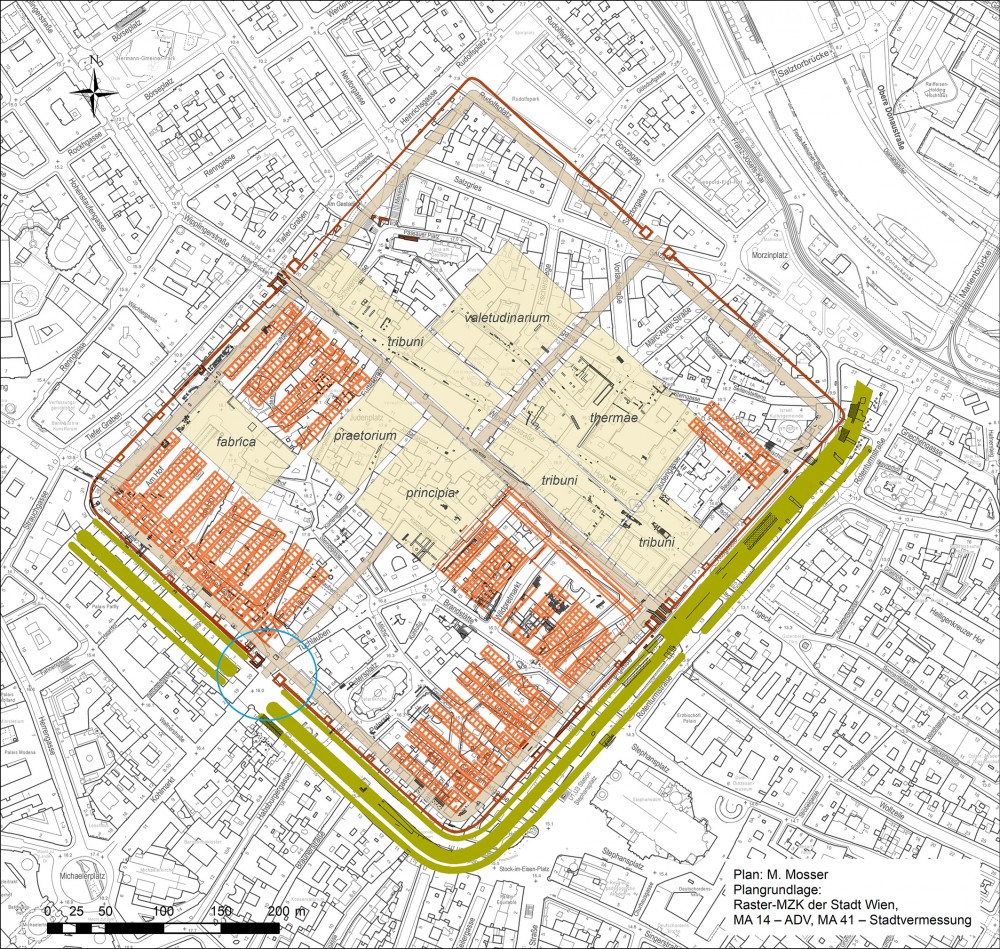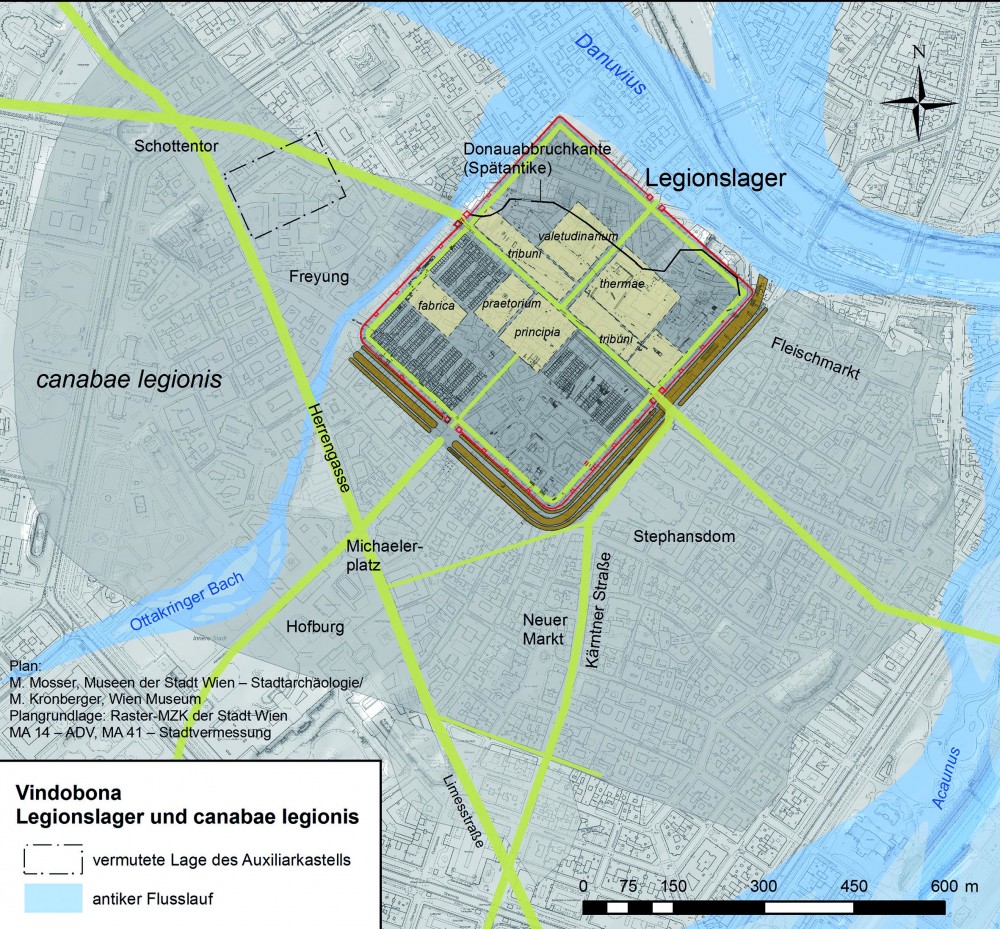Sensation: South Gate of Roman Fortress Vindobona Discovered within the City of Vienna
The foundation of the missing main gate Porta Decumana of the Roman legionary camp Vindobona came to light during construction works.
 Reconstruction of the southwestern main gate to Vindobona, the Porta Decumana. / Picture: © Stadtarchäologie Wien / 7reasons
Reconstruction of the southwestern main gate to Vindobona, the Porta Decumana. / Picture: © Stadtarchäologie Wien / 7reasons
![Vindobona, Roman Vienna, Das römische Wien<small>© Wikimedia Commons / de [CC BY-SA 2.0]</small>](https://www.vindobona.org/images/gallery/62236/gallery_news62236_image1-big.jpg)
![Vindobona around 250 A.D.<small>© Wikimedia Commons / eigene Arbeit [CC BY-SA 3.0]</small>](https://www.vindobona.org/images/gallery/62236/gallery_news62236_image2-big.jpg)
![The Peilertor in Vienna before 1732.<small>© Wikimedia Commons / Vienna Museum [Public Domain]</small>](https://www.vindobona.org/images/gallery/62236/gallery_news62236_image3-big.jpg)
![Drawing: The Romans build the fort Vindobona.<small>© Wikimedia Commons / Karl Ruß [Public Domain]</small>](https://www.vindobona.org/images/gallery/62236/gallery_news62236_image4-big.jpg)
![Floor heating of a tribune house in the Römermuseum.<small>© Wikimedia Commons / Bwag [CC BY-SA 4.0]</small>](https://www.vindobona.org/images/gallery/62236/gallery_news62236_image5-big.jpg)
![Marc Aurel crosses the Danube with his troops at Vindobona.<small>© Wikimedia Commons / Unbeannt [Public Domain]</small>](https://www.vindobona.org/images/gallery/62236/gallery_news62236_image6-big.jpg)
![Sketch of the legionary camp Vindobona (Vienna) around 130 A.D.<small>© Wikimedia Commons / Veleius [CC0]</small>](https://www.vindobona.org/images/gallery/62236/gallery_news62236_image7-big.jpg)
![Roman Museum, Vienna. Plan of Ancient Roman Vindobona.<small>© Wikimedia Commons / Wolfgang Sauber, 3. Juni 2011 [CC BY-SA 3.0]</small>](https://www.vindobona.org/images/gallery/62236/gallery_news62236_image8-big.jpg)


Archaeologists of the Vienna City Archaeology had a small sensation when they recently discovered foundation stones of the archway of the Porta Decumana (the main gate).
The discovery was made by chance when the road had to be dug up after a gas leak.
This made it possible to locate the Porta Decumana (also the main gate or in the case of Vienna the southwest gate), the southwest main entrance to the fort.
A few metres away, another cuboid was uncovered, which could have marked the centre of the roadway or the division of the gate. (see photo)
The stone blocks may have seen daylight again for the first time in more than a hundred years. At that time, pipes passing by were installed without having recognized the significance of the find.
A Roman legionary camp (Castra) usually has a rectangular shape with a cross on the axis according to which the camp main streets are aligned via principalis, via praetoria and via decumana.
These end at the four camp gates: porta principalis sinistra, porta principalis dextra, porta praetoria and porta decumana.
Also in Vindobona the Via Decumana ended in a city gate, precisely the Porta Decumana (the main gate). The Porta Decumana is located in the area of "Graben" and "Tuchlauben".
At the intersection of the crossroads (respectively the main streets) are the Command Building (principia) and the Residence of the Commander (praetorium).
The via principalis as transverse axis divides the camp into a smaller front section (praetentura - about one third of the total area) and a larger rear section (retentura - about two thirds of the total area).
In front of the walls bordering on both sides was the usual ditch with various defensive installations.
According to tradition, the gate itself existed until the 12th century. At the place of the Porta Decumana the so-called Peiler or Bairertor was established. This existed until 1731 (see photo).
The City Archaeology Vienna confirms that the Tuchlauben/Naglergasse site was closed again after the gas defect had been repaired and that there will be no further archaeological excavations at this site for the time being.
The City Archaeology Vienna (Stadtarchäologie Wien) will continue to carry out excavations and the subsequent processing as well as the scientific evaluation of the findings and finds that have come to light.
About Vindobona.org
Vindobona.org, the news portal for the international professional community of Vienna, takes its name from exactly this Roman camp. This choice of name is intended to highlight the changing international history of the city and metropolis of Vienna, in which people from different cultures have come together for more than 2000 years and have formed the unique cosmopolitan flair that characterizes modern Vienna.



